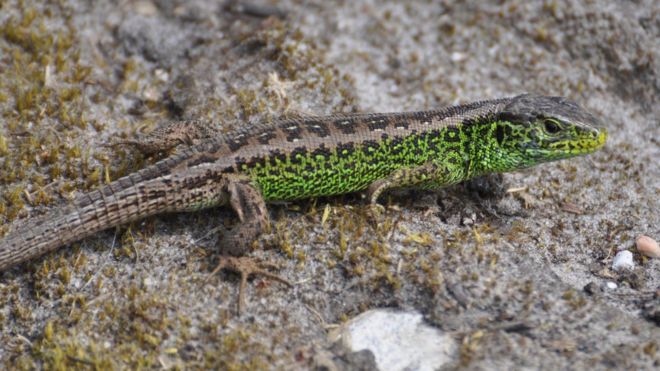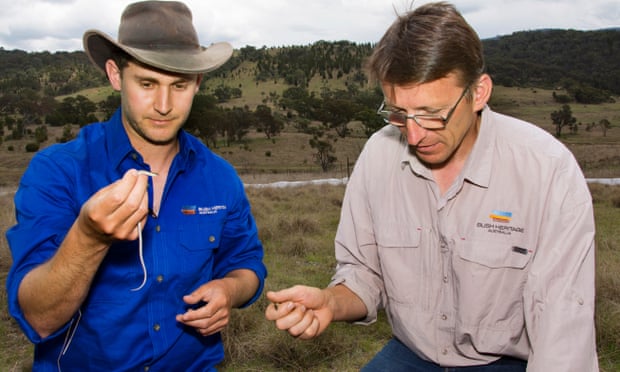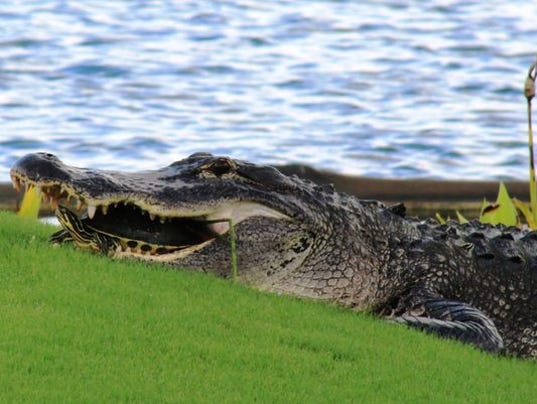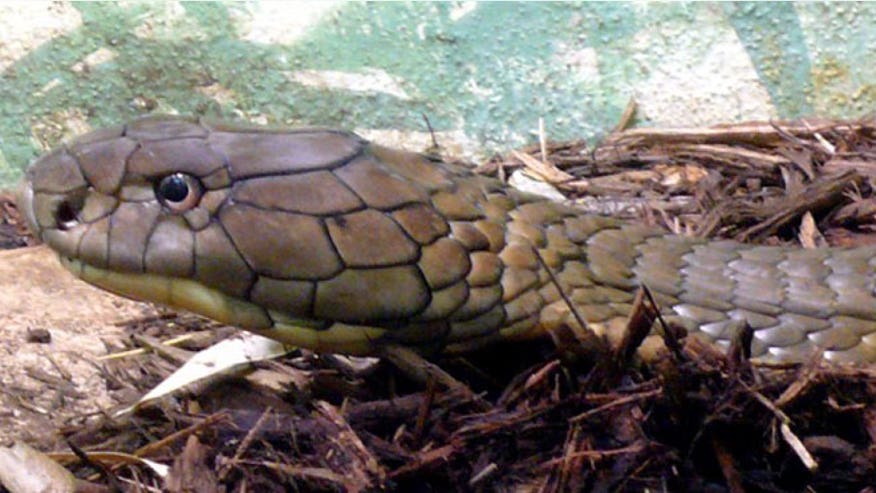Reptile & Amphibian
News Blog
Keep up with news and features of interest to the reptile and amphibian community on the kingsnake.com blog. We cover breaking stories from the mainstream and scientific media, user-submitted photos and videos, and feature articles and photos by Jeff Barringer, Richard Bartlett, and other herpetologists and herpetoculturists.
Friday, October 30 2015
Happy Rattlesnake Friday! We caught a tiger by it's tail with this (Crotalus tigris) in our herp photo of the day uploaded by kingsnake.com user kevinjudd ! Be sure to tell them you liked it here!

Upload your own reptile and amphibian photos photos at gallery.kingsnake.com, and you could see them featured here!
Thursday, October 29 2015

In the end it was probably the sign.
There is a right way to run a reptile education program, and then there are other ways.
The first thing any reptile educator needs to do is check to make sure they are not violating either state and local laws, unless they want to get a rather unpleasant education of their own.
Erstwhile reptile educator Jeremy Phillips in Louisville, KY learned this lesson the hard way, when on Tuesday, Louisville Metro Animal Services came and took his four venomous snakes away. Animal Services says that while Kentucky law allows those snakes, a Metro Louisville ordinance does not and the local ordinance supersedes the state law. Phillips says someone snaked him out and reported it to authorities, but he now wants a change in the Metro Louisville ordinance. Phillips will face a judge for his arraignment next month and his case is the first of its kind in Louisville.
He had been putting on free snake shows, but recently was asking for five dollars to cover costs of snake food and electricity to keep them warm. No one has paid for the shows. Phillips said he just put up a sign advertising his $5 snake shows, which he thinks may have gotten him in trouble.
Read more and watch the video at WDRB.com
A gorgeous field shot of a very dark Black Rat Snake brings memories of summer back in our herp photo of the day uploaded by kingsnake.com user cochran ! Be sure to tell them you liked it here!

Upload your own reptile and amphibian photos photos at gallery.kingsnake.com, and you could see them featured here!

Vertically elliptical during the daylight hours, the pupils of the Great Basin spadefoot are almost round on dark nights.
It has always amazed me how some relatively common—or even abundant—species can evade all efforts to find them. Or at least they evade almost all efforts. I encountered such difficulty when I was trying to photo the Great Basin spadefoot, Spea intermontana. Of course the fact that I lived in Florida, a couple of thousand miles east of the range of this taxon added significantly to the difficulty I had in encountering it.
Without going into a lot of the painful details, I’ll just say that on my first 3 attempts (about 13,000 miles of travel), I failed. Then on another trip, after Gary and I returned to the mainland from the Channel Islands (CA), I decided I REALLY wanted to succeed in finding this anuran. Gary knew a couple of locals only a couple of hundred miles away, so we got in the car, drove to the areas—and failed--again! Then Gary mentioned that he knew of a place in Washington, very near the Canadian border, where these critters would be calling—guaranteed. Lets see now. We were south of Los Angeles and the toads were east of Seattle—that was only about 1500 miles. So off we went. The good part for Gary was that he lived in Seattle. The bad part for me was that from Seattle I would have to drive another 3,000 miles diagonally across the USA. Awwww, what the heck. It was only gasoline, time---and as Patti later reminded me, money.
But as it turned out the spadefoots were out and calling in a vast sandy area that was still holding many pools of rainwater. And I finally—after 14,500 miles of trying—actually photographed them. But now I can’t remember why it was so very important to me(LOL).
Continue reading "Great Basin Spadefoot"
Wednesday, October 28 2015

How smart are reptiles? Can they be trained like other animals? You might be surprised at just how smart some of our reptilian friends are!
The San Diego Zoo recently released a video of one of their Anegada Iguanas( Cyclura pinguis) named Gus being trained using the target method. The Anegada Iguana is a endangered iguana species that was once distributed over the entire Puerto Rico Bank but its natural range is now restricted to the island of Anegada in the British Virgin Islands. Gus is part of the breeding program at the San Diego Zoo for this critically endangered species.
To watch the video, visit Reuters.
How cute is this baby Abronia graminia in our herp photo of the day uploaded by kingsnake.com user uggleedog ! Be sure to tell them you liked it here!

Upload your own reptile and amphibian photos photos at gallery.kingsnake.com, and you could see them featured here!
Tuesday, October 27 2015
This pile of noodles in our herp photo of the day uploaded by kingsnake.com user hermanbronsgeest reminds us of the variety in the most basic of "morphs", the normal! Be sure to tell them you liked it here!

Upload your own reptile and amphibian photos photos at gallery.kingsnake.com, and you could see them featured here!

This Peruvian example, an adult Phrynonax polylepis, has assumed a defensive posture.
Phrynonax polylepis? What in the world is that?
Actually it is a snake that you might know well. Think the Peruvian and Brazilian lineage of Pseustes poecilonotus, the common bird snake, aka the common puffing snake. As mentioned in an earlier blog this month, there has been a “shake up”—a reclassification of the genus once called Pseustes. The big yellow-bellied bird snake, once Pseustes sulphureus, is now Spilotes sulphureus. With this change the remaining 2 (now elevated to 3) taxa are in the genus Phrynonax. P. poecilonotus, once ranging from Central America to South America, has now been restricted to Central America. P. shropshirei, a yellow flecked black species, ranges from Panama to Colombia, Ecuador, and Venezuela and the species P. polylepis has been resurrected for the southernmost of the 2 South American forms. Based on current knowledge it is likely that at least 2 additional species will be erected.
Continue reading "The South American Bird Snakes"
Monday, October 26 2015

Photo: Allmusic, Facebook/Kevin Fowler
Country Musician Kevin Fowler recently took to facebook to criticize people he feels are "rattlesnake sympathizers".
“All of you people who cry about folks killing rattlesnakes have probably never seen what it looks like when you get bit by one,” wrote Fowler. “All of you rattlesnake sympathizers will change your tune when your kid gets bit playing in your backyard.”
The article does point out the obvious, that rattlesnakes prefer to be left alone and are often hiding for their safety thankfully.
To read the full article, visit Wide Open Country.

Brazilian Lancehead - Gallery Photo by Neverscared A nanofiber hydrogel infused with snake venom may be the best material to stop bleeding quickly, according to scientists at Rice University in Texas.
The hydrogel incorporates batroxobin, a venom produced by two species of South American pit viper. It can be injected as a liquid and quickly turns into a gel that conforms to the site of a wound, keeping it closed, and promotes clotting within seconds. The hydrogel may be most useful for surgeries, particularly for patients who take anti-coagulant drugs to thin their blood.
“It’s interesting that you can take something so deadly and turn it into something that has the potential to save lives,” Jeffrey Hartgerink Rice University
Batroxobin, also known as reptilase, is a snake venom produced by the Fer De Lance Bothrops atrox and Brazilian Lancehead Bothrops moojeni, venomous species of pit viper found in South America. Batroxobin was recognized for its properties as a coagulant in 1936 and has been used in various therapies as a way to remove excess fibrin proteins from the blood to treat thrombosis and as a topical hemostat. It has also been used as a diagnostic tool to determine blood-clotting time in the presence of heparin, an anti-coagulant drug.
See more at: http://news.rice.edu/2015/10/26/snake-venom-helps-hydrogels-stop-the-bleeding/
This little Frilled Dragon is ready to take no prisoners in our herp photo of the day uploaded by kingsnake.com user Mizzy every once in a while! Be sure to tell them you liked it here!

Upload your own reptile and amphibian photos photos at gallery.kingsnake.com, and you could see them featured here!
Friday, October 23 2015
Happy Rattlesnake Friday! Massive support is needed in the conservation of the gorgeous Massasauga Rattlesnake all across the country. That is why they take the spotlight today in our herp photo of the day uploaded by kingsnake.com user ratsnakehaven ! Be sure to tell them you liked it here!

Upload your own reptile and amphibian photos photos at gallery.kingsnake.com, and you could see them featured here!

This is the Mexican form of Spilotes pullatus, S. p. mexicana.
Spilotes, long a monotypic genus of beautiful black and yellow, neotropical, arboreal, snake, has recently become bitypic—and polymorphic. This was accomplished when a group of herpetologists (see paper mentioned below) undertook the reevaluation of the genus Pseustes, the bird snakes.
The result of their studies are that 3 species previously in the genus Pseustes are now in the resurrected genus Phrynonax and the 3 meter long, olive and brownish Pseustes sulphureus has become Spilotes sulphureus.
In a facebook quote Cesar Barrio Amoros (a member of the research team) stated “in this article we change the use of Psustes (sic) (no longer a valid genus) per Phrynonax for poecilonotus, shoepshirei and polylepis and sulphureus become Spilotes.”
In explanation of the above, with the removal of Pseustes sulphureus, the type species of the genus, Psuestes becomes an invalid generic name and has necessitated the elevation of the senior synonym, in this case Phrynonax as the valid name for the remaining 3 taxa.
So those among you who used to have Pseustes sulphureus now have Spilotes sulphureus and those that have any of the other three Pseustes species now have Phrynonax sp. But fret not. As long as they are properly cared for the snakes couldn’t care less.
And for further information please reference: Jadin, R., Burbrink, F., Rivas, G. Vitt, L., Barrio-Amorós, C.L. & Guralnick, R. 2013. Finding arboreal snakes in an evolutionary tree: phylogenetic placement and systematic revision of the Neotropical birdsnakes. J. Zoolog Syst Evol Res doi: 10.1111/jzs.12055: 1-8.
Continue reading "And Now There Are Two! The Genus Spilotes is now Bitipic"

Photo: Chris Dresh
Ecologists have been working to protect rare reptiles from roadworks on a busy dual highway by luring them away from the A338 in Bournemouth, England. Instead of a forceful relocation, the ecologists in Bournemouth changed the landscape, directly impacting the road changes only, to allow the animals to relocate naturally.
Dorset County Council's environment councillor, Peter Finney, said: "We're incredibly proud of our natural environment in Dorset and we strive to find new ways to work alongside our many protected areas and species, and enhance it - even when we are doing something as destructive as rebuilding a road."
To read the full article, visit The BBC.
Thursday, October 22 2015
 Among those who search for reptiles in North America, there has always been great interest in Eastern Hognose Snakes, Heterodon platirhinos. They are beautiful, variable, display unique behaviors, have an interesting natural history, and are unlike all the other snakes we find locally.
Getting a nice picture of a wild Eastern Hognose Snake can be very difficult because they will roll over on their back and play dead when they feel threatened, and once they go into this routine it is not only hard to make them stop, but they also seem to never look as good once they play dead. During their defensive process they tend to disgorge their belly contents and also stop filling up with air to hiss which makes them look thin and deflated. Take my advice and try to get your pictures of this species before they feel too disturbed and roll over on their backs.
Neophytes will quickly reach down and pick up snakes as soon as they are discovered. When a specimen is discovered the best thing to do is to try to get pictures immediately. When I am on Hognose hunting grounds I carry my camera with me, sometimes it is even already turned on. If the snake tries to escape use a stick or branch to move the animal but whatever you do, DO NOT TOUCH IT WITH YOUR HAND! For whatever reason, these snakes are less disturbed by the feel of natural materials but the feel of your hand will often cause them to play dead upon contact. THINK when you find one of these snakes! Calm down and be patient. Do not give up. Instead, just focus on keeping the snake calm. They will often turn their heads sideways just before they flip on their backs, so if you see them doing this back off a little bit. If they do flip over you can put the snake in a bag for 20 minutes and then carefully dump it out and try again, but even if this works the snake will not look as good as it did the moment you found it. I hope this information proves useful and I wish everyone good luck in finding and getting nice pictures of these spectacular snakes!
Gotta love the up close head shot of this Tokay Gecko in our herp photo of the day uploaded by kingsnake.com user The_Reptiles_Den ! Be sure to tell them you liked it here!

Upload your own reptile and amphibian photos photos at gallery.kingsnake.com, and you could see them featured here!

Photo: Freshwaters Illustrated/Dave Herasimtschuk/USDA.
In the race to save our dying amphibians, a fish endocrinologist developed "Cupids Syringe" also known as Amphiplex. The hormone based chemical helps to encourage better captive breeding.
Trudeau knew that the hormone systems controlling mating were nearly identical in fish and mammals, and he reasoned that they should be similar in amphibians, too. Taking a page out of the fish reproduction playbook, he combined a hormone that stimulates cells in the pituitary gland with a chemical that blocks the neurotransmitter dopamine, which can interfere with breeding. This combination had been used extensively in fish, to encourage breeding stock for the aquaculture industry. But it hadn’t yet been tried in amphibians. Before Amphiplex, only individual hormones, sans dopamine blockers, had been used on captive amphibians, with mixed success.
To read the full article, visit Mongabay.
Wednesday, October 21 2015

Tank, sphagnum, light, and sturdy plants provide an easily built and maintained amphibian terrarium.
All that is needed to make a very pretty terrarium for horned and other bulky frogs with limited leaping ability is the tank (ours is a 40 gallon), a complete cover (with horned frogs a cover may not be needed) but if arboreal species are housed within not only is a cover needed but a suitable perch should also be provided, a suitable light, enough good quality unmilled sphagnum moss to provide a 3” deep bottom cover, a few hardy plants (I prefer philodendrons, “pothos” or similar nearly indestructible species, and, of course, the frog inhabitant. Since the sphagnum will be kept damp and clean, unless you are intending to breed the species a water container is optional. If a water container is provided be sure the water is kept clean. Ditto with the sphagnum bottom cover. To prevent the sphagnum from being ingested by a hungry frog, food items may be proffered on forceps or from the fingers (the latter sometimes and with some species not being an especially good idea!). With an escape proof top this setup also works well for salamanders.
From this point on pictures will probably be the most descriptive. I hope you enjoy your frogs as much as I do mine.
Continue reading "A Very Simple Terrarium for a Very Phat Phrog"

Photo: Annette Ruzicka/Bush Heritage Australia
The habitat of the Australian Legless Lizard population in Canberra is set to be razed in preparation to build an RV park for tourists to rest their weary heads. Conservationists from Bush Heritage Australia are working to save one of the last remaining groups of this species.
To capture these legless lizards – the name comes from legs that disappeared through evolution leaving just a scaly protrusion – Bush Heritage has purchased roof tiles in bulk.
About 800 have been strewn across the area for the proposed caravan park. The idea is simple but effective. Reptiles like to press themselves against heated surfaces to get warm. As the sun heats the tiles, legless lizards will wriggle underneath them.
To read the full article, visit The Guardian.
The name says it all. Check out this stunning Cherry Bomb Blood Python in our herp photo of the day uploaded by kingsnake.com user jsignoretti every once in a while! Be sure to tell them you liked it here!

Upload your own reptile and amphibian photos photos at gallery.kingsnake.com, and you could see them featured here!
Tuesday, October 20 2015
One of the most common amphibians out there, this Albino Clawed Frog is just hanging around in our herp photo of the day uploaded by kingsnake.com user bradtort every once in a while! Be sure to tell them you liked it here!

Upload your own reptile and amphibian photos photos at gallery.kingsnake.com, and you could see them featured here!
Monday, October 19 2015

Photo: Inside EditionA pair of conjoined twins were able to be successfully separated by their breeder.
"To my surprise, the reason the baby couldn't exit was because it was attached to its twin," he told INSIDE EDITION. "I helped them out of the egg and discovered they were joined at the yolk sac which is basically the equivalent to an umbilical. Immediately we knew we had a bit of a challenge on our hands."
To read the full article and see the video, visit Inside Edition.
What better way to start out this week than with this cute Nile Monitor in our herp photo of the day uploaded by kingsnake.com user Mantafish every once in a while! Be sure to tell them you liked it here!

Upload your own reptile and amphibian photos photos at gallery.kingsnake.com, and you could see them featured here!
Sunday, October 18 2015

Photo: The News-Press
Despite being an apex predator, one unlucky Alligator learned there are things scarier than him, like a golf cart.
The gator's plan for a nice meal was all set in motion when the turtle found itself surrounded by the alligator's teeth. The turtle remained incarcerated by the alligator's gaping mouth until a golf cart scooted close enough to scare the gator back into the lake, Backman says.
To read the full article, visit USAToday.
Saturday, October 17 2015

Photo: StevenDavidJohnson.com and Wild Virginia
A Virginia pipeline may need to change it's route to avoid potential impact on two special of Salamanders, the Cheat Mountain salamander and the Cow Knob salamander.
It recommends changing the route of the pipeline to avoid as much of the salamanders' habitats as possible, possibly going south of South Sister Knob and Chestnut Ridge or north of Romney, West Virginia.
Another proposal would have the pipeline construction crews bore through Shenandoah Mountain, but that would not eliminate impacts on the habitats of the two species.
To read more visit Newsplex.com.
Friday, October 16 2015
Happy Rattlesnake Friday! All venomous snakes need our support! This Cottonmouth is screaming it from the field in our herp photo of the day uploaded by kingsnake.com user BowieKnife357 ! Be sure to tell them you liked it here!

Upload your own reptile and amphibian photos photos at gallery.kingsnake.com, and you could see them featured here!

Photo: Fox News
Despite their best attempts to track global venomous snake bites, many Asian countries are unable to properly count the number of people envenomated annually. Due to the lack of available health care in some regions as well as the inability to pay for it leads many bites to not be counted.
Citing new evidence from a study in India and Bangladesh, the experts said around 46,000 people died annually of snake bites in India, plus another 6,000 in Bangladesh. The WHO estimates the annual death toll in India from snake bites is 10,000.
"Snake bite ... is almost completely ignored and grossly underestimated," said Alan Harvey, head of the International Society of Toxinology, who led the meeting.
"WHO and governments need to ... rank snake bite where it belongs -- as a very real public health and medical concern which needs funding, training and focus."
To read the full article, visit Fox News.
Thursday, October 15 2015
Hope you enjoy a little something out of the wild with this Mud Snake in our herp photo of the day uploaded by kingsnake.com user Godfrey every once in a while! Be sure to tell them you liked it here!

Upload your own reptile and amphibian photos photos at gallery.kingsnake.com, and you could see them featured here!

Beautiful in any setting, this Inyo Mountains slender salamander seemed especially so against the desert background.
“Next right” Gary said. “It’s just a mile or two up the road.”
”OK. Whoops you mean here?”
“Yes. I guess we’ll have to roll the boulders.”
So we huffed, puffed, strained, and somehow moved the huge rocks just enough to allow the car to sneak carefully through.
Ahead of us was a rocky trail that seemed to go a few hundred feet into the desert, up a rise, and then peter out entirely.
With Gary directing we got to the end of the trail. Then carefully avoiding rocks we managed to go a few hundred feet farther.
“We walk from here.”
And walk we did. Over the rise, then down to an orchid laden desert spring, along a marsh, and following the run, to a desert wonderland, a willow surrounded waterhole thickly edged with flat fist-sized rocks.
“Go to it” Gary said, “but be sure to replace the rocks as close to the original position as possible.”
So I did and I did, and within minutes I had uncovered, photographed, and returned to its hiding place one of the most beautiful salamanders I have yet seen, a light phase Batrachoseps campi, Inyo Mountain salamander. These deserts are just alive with amphibian surprises. Thanks again, Gary.
Continue reading "A Desert Salamander"

Photo: Don Lyman
Despite being listed as endangered on the IUCN Red List, the Blanding's Turtle is not federally protected in the US, although some states have regulations in place. Biologist Jared Green of Assabet River National in Hudson, Massachusetts, however wants to help increase their numbers in his state. The program hit a major milestone this spring releasing their One-thousandth turtle.
Biologists hope that building a strong population of Blanding’s turtles at Assabet River will help offset population losses being experienced by the turtles elsewhere.
Although there are some big Blanding’s turtle populations in the Midwest, most populations in the Northeast are less than 50 turtles, Butler says. The only large population is at Oxbow NWR, where an estimated several hundred Blanding’s turtles make their home. “That’s virtually unheard of east of the Mississippi,” explains Butler.
Read more at Earth Island Journal.
|



